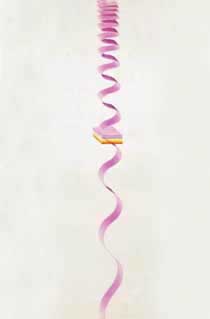DK Science & Technology: Telecommunications
Telecommunications are messages carried around the world in seconds by electric signals and waves from the ELECTROMAGNETIC SPECTRUM. They include radio and television broadcasts, and telephone conversations.
A satellite bounces telecommunications signals from one side of Earth to another. The satellite travels in a geostationary orbit so that it stays over the same point on Earth’s surface at all times.
A telephone has a microphone and an earpiece. The microphone converts sound into an electric signal. The signal travels at the speed of light along wires, through optical fibers, or via microwaves. A network connects the phones. The earpiece contains a loudspeaker. This changes the signal back into sound.
Radio broadcasts are made from a central transmitter. Sound signals from microphones in the radio studio are combined with radio waves broadcast from an antenna. Your radio at home has a receiver that separates the sound signal from the radio signal and sends it to a loudspeaker. This is the sound you hear.
An analog television transmitter sends pictures and sounds as a pattern of radio waves through cables. DIGITAL BROADCASTS transmit the sounds and pictures in binary code through cables and satellites.
A cell phone sends and receives signals using microwaves. A phone has a range of only a few miles, so land-based aerials are used. The area that each aerial covers is called a cell. A phone exchanges signals with the nearest aerial. As you move from cell to cell, the phone changes aerials. The aerials are connected to the global telephone network.
Scientist and inventor Guglielmo Marconi made the first radio transmissions in 1894. His transmitter rang a bell 30 ft (10 m) away. By 1901, he had developed his invention and made the first wireless transmission across the Atlantic Ocean from England to Canada. Marconi was awarded the Nobel Prize for Physics in 1909.
Electromagnetic rays are waves of electromagnetic force that travel at the speed of light. The full range of rays make up the electromagnetic spectrum.
Electrons produce radio waves as they vibrate. They are low-frequency, long-wavelength waves. Radio broadcasts use the lower-frequency range of radio waves, and television broadcasts use the higher range.
Waves are grouped in wave bands by frequency. Low- to medium-frequency wave bands travel far, and are used for shipping signals. High-frequency waves are used for radio and telephones. The ultra-high to extremely high-frequency bands carry huge amounts of information, including TV, cell phone, and radar signals, and microwave communications.
Have you seen television pictures as clear as computer graphics? In a digital broadcast, sounds and pictures are converted into streams of binary numbers. The result is higher-quality reception, and many more channels.
Digital TV converts sounds and images into binary code. The code is carried on electromagnetic waves. Digital pictures are clearer because binary code can be compressed (made smaller) to send lots more information about the picture to the receiver. Broadcasters can also send more channels this way.

